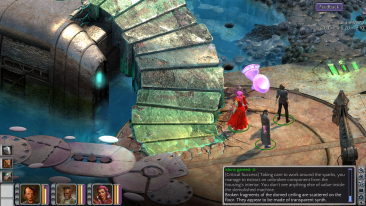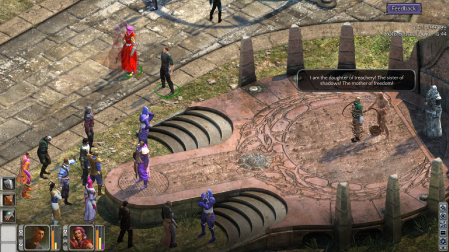As many of you know, I’m eagerly awaiting the release of Torment: Tides of Numenera later this month. Unfortunately, what should have been an exciting and happy time has been marred by a number of PR blunders on the part of the developers.
The most visible issue has been the news that some of the stretch goals from the Kickstarter campaign won’t make it into the finished game. The crafting system and at least two of the companions are gone entirely, while the Bloom has replaced the Oasis of M’ra Jolios as the secondary hub city.
The latter change is probably the most defensible. The Bloom is a city within the guts of a vast interdimensional creature, while M’ra Jolios is an aquatic community within a giant orb of water in the middle of the desert. M’ra Jolios is cool and all, but the Bloom is arguably a better fit with Torment‘s themes (M’ra Jolios will still be in the game, albeit in a smaller capacity).
I can’t get terribly worked up about the lack of crafting. I find it a chore in most games, and I agree with the designers that it didn’t mesh well with the Torment paradigm. It always seemed like something that had been tacked on in order to pad out the stretch goals, so its departure is probably a good thing.
The loss of two companions is more lamentable. I like being able to choose from a large pool of companions. Being able to go through the game with an entirely different group each time is a lot of fun, and it adds a lot of replayability. But in Torment, the total companion pool will be six. Since you can have up to three companions in your party, it won’t take many playthroughs to experience all of the companions. I’m also bummed that one of the companions I was most excited about, a numenera known as ‘The Toy,’ is one of the ones that got cut (The Toy was supposed to be a protean object that would change based on your character’s wishes, and I thought it would be a great way to show the Ninth World’s pervasive weirdness). The developers argue that they had to reduce the number of companions in order to ensure a satisfying level of depth and reactivity for each one, but this excuse rings a bit hollow given how long the game has been in development and how much money inXile has raised.
But missing stretch goals aren’t Torment‘s only problem. InXile also announced that the game won’t receive Italian localization. This wouldn’t be a big deal if they were making an ARPG like Diablo III or Grim Dawn where the story is secondary to the action. With games like those, you don’t need to have a solid grasp of English to enjoy the game. On the other hand, you need to be very comfortable with the language in a story-driven game like Torment. (I’m decent at reading German, but I couldn’t imagine playing the German version of Torment; I think I’d miss out on a lot of the little nuances and subtleties that make the writing pop).
InXile argues that, given the game’s titanic script, localization would be extremely pricey, and if their past sales in Italy are any indication, they are unlikely to recoup that money. But this wasn’t a stretch goal–they’ve been promising Italian localization from Day 1. That seems like an odd things to do if Italian sales were likely to be so anemic. Surely it would have made more sense to focus on the most profitable localizations first and save the less lucrative ones for stretch goals.
Also troubling is the uncertainty over whether or not current backers can opt to receive the console version of the game instead of a computer version. When Torment was first announced, it was supposed to be a computer-only title, but toward the end of the game’s development, inXile entered into an agreement with Techland to bring the game to consoles as well. A number of people who backed the game when it was computer-only now want to avail themselves of the console version, but inXile hasn’t offered them the chance to make the switch. To be fair, this matter might well be beyond their control. Consoles are closed ecosystems, and if Microsoft and Sony won’t let them offer a switch, there’s nothing they can do about it. Still, it’s a shame that the people who supported the game from the very beginning could find themselves at a disadvantage.
This isn’t the only way that backers are being shafted. As part of their deal with inXile, Techland is releasing their own Torment collector’s edition that includes special goodies that won’t be available to backers, including a smaller version of the First Castoff statue that only available to backers who pledged $2,000 or more. The retail collector’s edition, on the other hand, will cost less than $100. To make matters worse, backers won’t even be able to purchase the Techland swag a la carte.
Technically, this won’t impact me since I’m getting the digital collector’s edition, but I understand why some of my fellow backers are upset. It’s a bit obnoxious that the people who supported the game from the very beginning won’t have access to the full suite of bonus items. The smaller version of the statue is a particularly galling example. InXile should have known that it would generate a lot of interest from backers since the larger version would have been beyond the reach of a lot of people. I realize that backers get certain benefits that ordinary Day 1 customers do not (e.g., having their name in the credits, designing in-game monuments), but that’s beside the point. As a matter of principle, backers should be able to choose any reward since their support made the game what it is.
To be fair, inXile is aware of these issues and appears to be trying to make amends. Italian customers have been offered refunds, and inXile is trying to figure out a way to allow backers to exchange the computer version for a console version. They’ve also hinted that some of the cut companions might be introduced later as DLC, which backers will get for free. Alas, it doesn’t seem they can do anything about the Techland swag due to the nature of their agreement with Techland.
The sad irony in all this is that these mistakes were basically own goals on inXile’s part. If inXile had been honest and upfront with the fans, there would probably be a lot less anger. The fact that fans only found out about some of these issues thanks to the detective work of other fans only exacerbated tensions between the community and the developers. Amazingly, inXile does not seem to have a dedicated PR person, relying instead on members of the development team. The problem with this approach is that it’s easy for team members to get swamped with other things and let PR fall by the wayside. I got a glimpse of this when I was writing an article about Torment for Urban Gaming Elite and discovered that some of the information about the game on inXile’s own website was woefully out of date!
These quibbles aside, I’m still stoked for Torment‘s release. The beta has been awesome, and I believe the game will go down in history as a worthy successor to Planescape: Torment. I just hope inXile learn from these last-minute problems so that future projects can avoid this type of drama.

 hes and bugs, TTON appears to have a solid foundation. But I do have a few minor complaints. For example, at one point I died (like in Planescape, you’re immortal, and you simply respawn when you die), and I ended up in a totally different part of the city. There is no world map or fast-travel feature, so I had to spend a lot of time running around in order to find my way back to where I needed to be. At the time, I happened to be in the middle of a quest to save someone from execution, and I wasn’t sure if I had time to explore since one of my companions kept reminding me that the condemned man would soon be dead. Happily, inXile appears to have taken steps to fix this in the first beta patch. After dying post-patch, an NPC gave me directions to get me back on track. But his directions were connected with a specific quest, and I don’t know what would have happened if that quest hadn’t been active.
hes and bugs, TTON appears to have a solid foundation. But I do have a few minor complaints. For example, at one point I died (like in Planescape, you’re immortal, and you simply respawn when you die), and I ended up in a totally different part of the city. There is no world map or fast-travel feature, so I had to spend a lot of time running around in order to find my way back to where I needed to be. At the time, I happened to be in the middle of a quest to save someone from execution, and I wasn’t sure if I had time to explore since one of my companions kept reminding me that the condemned man would soon be dead. Happily, inXile appears to have taken steps to fix this in the first beta patch. After dying post-patch, an NPC gave me directions to get me back on track. But his directions were connected with a specific quest, and I don’t know what would have happened if that quest hadn’t been active.